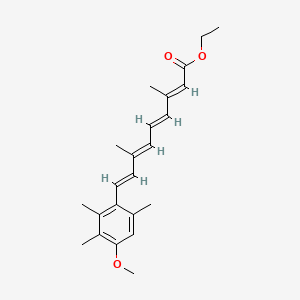| Authors | Title | Published | Journal | PubMed Link |
|---|---|---|---|---|
| Gottlieb S et al. | Cellular actions of etretinate in psoriasis: enhanced epidermal differentiation and reduced cell-mediated inflammation are unexpected outcomes. | 1996 | J. Cutan. Pathol. | pmid:8915849 |
| Danno K et al. | Alterations in ICAM-1 and ELAM-1 expression in psoriatic lesions following various treatments. | 1996 | J. Dermatol. Sci. | pmid:8902653 |
| Altomare G et al. | Sweet's syndrome in a patient with idiopathic myelofibrosis and thymoma-myasthenia gravis-immunodeficiency complex: efficacy of treatment with etretinate. | 1996 Jan-Feb | Haematologica | pmid:8900854 |
| Schepers C et al. | Papuloerythroderma of Ofuji: a report of 2 cases including the first European case associated with visceral carcinoma. | 1996 | Dermatology (Basel) | pmid:8884150 |
| Maier H and Hönigsmann H | Concentration of etretinate in plasma and subcutaneous fat after long-term acitretin. | 1996 | Lancet | pmid:8874484 |
| Pomponi F et al. | Retinoids irreversibly inhibit in vitro growth of Epstein-Barr virus-immortalized B lymphocytes. | 1996 | Blood | pmid:8874215 |
| Schmitt-Hoffmann AH et al. | Mechanistic studies on the ethyl-esterification of acitretin by human liver preparations in vitro. | 1995 | Life Sci. | pmid:8847958 |
| Panzarella K and Camisa C | Coexistence of superficial pemphigus and psoriasis. | 1996 | Cutis | pmid:8804843 |
| Lacour M et al. | An appraisal of acitretin therapy in children with inherited disorders of keratinization. | 1996 | Br. J. Dermatol. | pmid:8763418 |
| Van Dooren-Greebe RJ et al. | Prolonged treatment with oral retinoids in adults: no influence on the frequency and severity of spinal abnormalities. | 1996 | Br. J. Dermatol. | pmid:8745889 |
Etretinate
Etretinate is a lipid of Prenol Lipids (PR) class. Etretinate is associated with abnormalities such as Psoriasis, Skin lesion, Scleroderma, Chronic graft-versus-host disease and Evaluable Disease. The involved functions are known as Agent, Ulcer and Teratogenesis. Etretinate often locates in Hepatic and Skin. The related lipids are Steroids and Steroid, Systemic.
Cross Reference
Introduction
To understand associated biological information of Etretinate, we collected biological information of abnormalities, associated pathways, cellular/molecular locations, biological functions, related genes/proteins, lipids and common seen animal/experimental models with organized paragraphs from literatures.
What diseases are associated with Etretinate?
Etretinate is suspected in Scleroderma, Chronic graft-versus-host disease, Psoriasis, Skin lesion, Evaluable Disease, Pneumonia, Bacterial and other diseases in descending order of the highest number of associated sentences.
Related references are mostly published in these journals:
| Disease | Cross reference | Weighted score | Related literature |
|---|
No disease MeSH terms mapped to the current reference collection.
PubChem Associated disorders and diseases
What pathways are associated with Etretinate
There are no associated biomedical information in the current reference collection.
PubChem Biomolecular Interactions and Pathways
Link to PubChem Biomolecular Interactions and PathwaysWhat cellular locations are associated with Etretinate?
Visualization in cellular structure
Associated locations are in red color. Not associated locations are in black.
Related references are published most in these journals:
| Location | Cross reference | Weighted score | Related literatures |
|---|
What functions are associated with Etretinate?
Related references are published most in these journals:
| Function | Cross reference | Weighted score | Related literatures |
|---|
What lipids are associated with Etretinate?
Related references are published most in these journals:
| Lipid concept | Cross reference | Weighted score | Related literatures |
|---|
What genes are associated with Etretinate?
There are no associated biomedical information in the current reference collection.
What common seen animal models are associated with Etretinate?
There are no associated biomedical information in the current reference collection.
